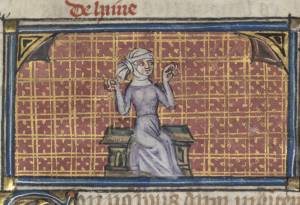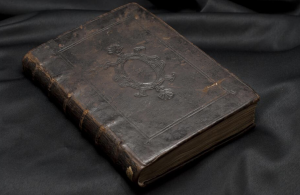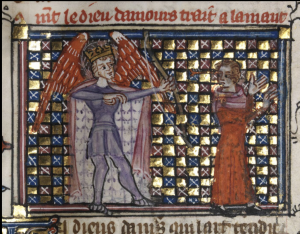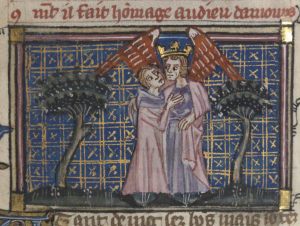It is to our dismay that modern ladies are constantly questioning the norms of love, particularly if chivalry is dead among men in the age of Tinder and Instagram direct messages. The art of love, however, is not only a recurring element limited to the present day but also a notable theme commonly attributed to medieval literature. Roman de la Rose, or the Romance of the Rose, a manuscript which consists of the popular allegorical French poem, is amongst the most decorative medieval manuscripts. A secular work once prolific and widely reproduced, Roman de la Rose, is an epitome of courtly literature presented through chivalric language and intricate imagery. In this manuscript, illustrations become effective visual devices that successfully present a courtly view of love, through utilization of olive brown ink, gilded letters, and exquisite miniatures. Moreover, the content of the manuscript – a poem of a courtier’s attempt to find his beloved, is further emphasized through these detailed illustrations. The rendering of poetry and illustration alters our interpretation of the manuscript by reinforcing its purpose as a comprehensive handbook on the art of love and affirming the virtuosity of courtship. In addition, lavish miniatures, binding and extensive use of rare pigments indicate the manuscript was of high economic value and commissioned for the aristocratic class.

A close anatomical examination of the manuscript Roman de la Rose reveals the deliberate effort medieval artisans made to produce such elusive designs. The manuscript is written in Old French and displayed in two columns. Most of its miniatures are found in the first part of poem (ff. 3-26v), while few other illuminations are included throughout the latter part of the poem (ff.28-130) and Le Testament (ff.138-149), an additional work bounded at the back of the manuscript (Aberystwyth, National Library of Wales, NLW MS 5016D). Roman de la Rose consists of 150 folios of vellum made from premium calfskin. High patronage is suggested with the materials of the manuscript. Since fine vellum was rare, the commission of the manuscript must have been supported by the exceptionally wealthy.

In addition, the manuscript was also rebounded around the sixteenth century. The present pasteboard covers are painted with black morocco, along with a fillet frame (a small piece of decorative molding beneath a frame) and a monogram of two intertwined letters C (Huws, Daniel. “NLW MS 5016D”). Despite the later added covers, the fundamental structure of the binding remains. Scholars date the five double whittawed thongs, or leather thongs used for support in bookbinding, earlier than the present covers if not original (Huws, Daniel. “NLW MS 5016D”). From these features, we can gather the manuscript was of high literary value since the rebinding process is usually lengthy and costly. The interest in preservation also suggests the manuscript’s extraordinary artistic renderings were worth deconstructing and reassembling. Perhaps, the ornately gilded capital letterings and lavish courtship miniatures brought attention to artisans of later eras, who took the initiatives to continue its legacy. On the other hand, scholars find the size of the manuscript noteworthy. The small folio measures 282 x 202mm (Huws, Daniel. “NLW MS 5016D”), from which we can deduce that the manuscript was portable. It is likely that the manuscript was carried around by aristocratic figures and used as a guide to court ladies or possibly as a leisure reading as well. However, this manuscript was not limited to solely upper-class literates, but also illiterate laypeople. Clear and imaginative illuminations made the text more accessible to the public by creating a clear visual interpretation of the poem itself. The accessibility of text and imagery contributed to Roman de la Rose’s widespread influence among the population of the fourteenth century.

Aside from its physical attributes, Roman de la Rose is also influential for its literary qualities. The manuscript is deemed as “the most influential of all romances produced in medieval France” (Friend of the Library, Winter 2002). Originally, Roman de la Rose is a poem divided into two parts – first, a dream vision written by Guillaume de Lorris; the latter a cynical conclusion of love written by Jean de Meun. While the subject of the poem revolves around a courtier’s quest for his maiden, the poem is inundated with metaphors and concepts associated with the “proper” courtly society. For instance, the high walls of enclosed gardens in which the maiden resided, were metaphors for women confinements and expectations for women at the time. The manuscript also exemplifies medieval ideals of men. Virtuous services knights perform to woo their ladies are constantly emphasized throughout the manuscript. In illumination, The God of Love shoots an arrow at l’Amant from fol. 13r, the God of Love is presented as a courtier wielding a bow with an arrow shot through the maiden’s head (Aberystwyth, National Library of Wales, NLW MS 5016D). He is shown in typical medieval clothing, wearing a purple cotehardie tailored tightly to fit his torso and arms. His detailed maroon cape and golden crown are indications of his heritage and his divine status, illustrating what a medieval archetypal man should resemble. On a symbolic level, this scene may be associated with mythological Greco-Roman cherubic infant Cupid, who was also known as the god of love and desire. God of Love’s iconographic arrow resembles that of Cupid’s, which wounded both mortals and even deities with ordeals of love. This scene also allegorizes God of Love as an idealistic knight attempting to flatter the maiden with his mighty strength and courage – a recurring imagery and theme throughout the manuscript. The continuous depictions of virtuous knighthood throughout the manuscript manifest courtly love, which was prevalent in chivalric literature at the time.

A careful examination of the stylistic details of the manuscript proves that its illuminations are nothing short of extraordinary. In the miniature, The Lover Performs Homage to Amors from fol. 15r, a scene of the courtier holding his beloved in his arm is presented with bordering gold foil and red ink (Aberystwyth, National Library of Wales, NLW MS 5016D). The use of lavish designs and colors such as gold and red pigments not only highlight the importance of the manuscript but also further implies that the artisans who created the manuscript were highly skilled. Aside from the foreground of the two figures, the blue background of the miniature is filled with gold vertical and horizontal lines. The blue pigment used recurrently throughout the manuscript may have been imported from the Middle East. Medieval blue pigments are usually extracted from rare minerals such as lapis lazuli and azurite, hence the commission of the manuscript must have been under strong financial support.
Roman de la Rose is an intermingling of chivalric poetry and exquisite miniatures: manifestations of ideal courtly love in the fourteenth century. These vivid illuminations contribute to the didactic purposes of the manuscript, serving the upper class an allegorical guide to the Art of Love. Generous use of materials such as gold foil and premium vellum, commodities unavailable to laypeople then, also indicates the economic value of the manuscript. With its plethora of highly detailed miniatures and gilded letters, Roman de la Rose is an exquisite piece filled with sophisticated designs unparalleled to any romance medieval manuscripts. From the assortment of colors, binding, lavish illuminations, and preservation efforts, Roman de la Rose is truly an art piece. In addition, an effective epitome for the virtuosity of courtship, skillful stylistic elements, and display of fourteenth-century love.
Works Cited
Huws, Daniel. “NLW MS 5016D.” The Romance of the Rose Illuminated: Manuscripts at the National Library of Wales Aberystwyth. Ed. Alcuin Blamires and Gail C. Holian. Tempe: Arizona Center for Medieval and Renaissance Studies, 2002. 121-25.
Lloyd-Morgan, Ceridwen, ‘The Romance of the Rose Illuminated: Manuscripts at the National Library of Wales’, Friend of the Library, (Winter 2002), 13-15.
“Roman de la rose – Romance of the rose.” Llyfrgell Genedlaethol Cymru – The National Library of Wales: Roman de la Rose, www.llgc.org.uk/darganfod/oriel-ddigidol/llawysgrifau/yr-oesoedd-canol/roman-de-la-rose/.
Duby, Georges, and Arthur Goldhammer. A History of Private Life, Vol 2 Revelations of the Medieval World. The Belknap Press of Harvard University Press, 2003.